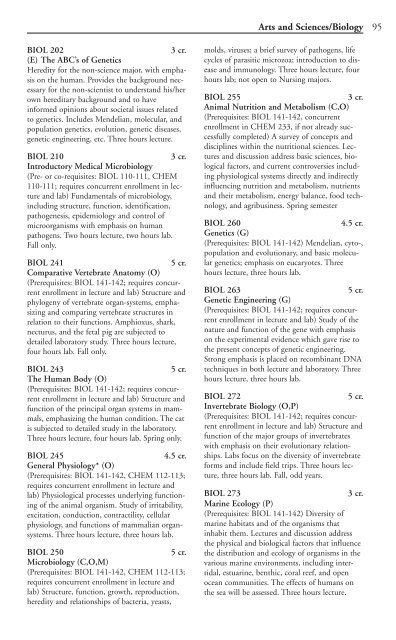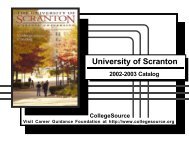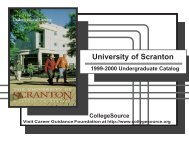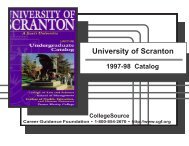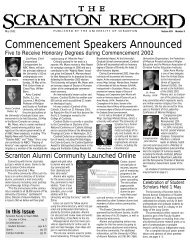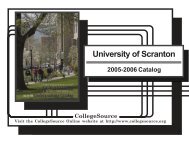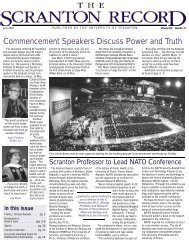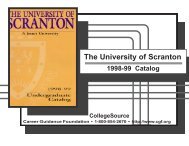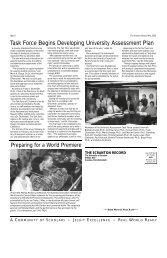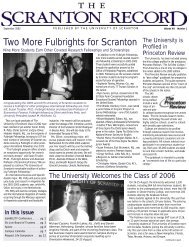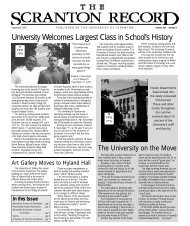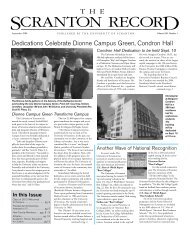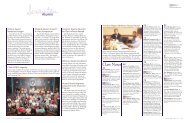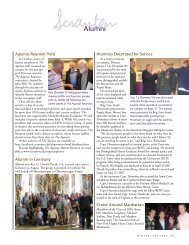2003-2004 - The University of Scranton
2003-2004 - The University of Scranton
2003-2004 - The University of Scranton
You also want an ePaper? Increase the reach of your titles
YUMPU automatically turns print PDFs into web optimized ePapers that Google loves.
BIOL 202 3 cr.<br />
(E) <strong>The</strong> ABC’s <strong>of</strong> Genetics<br />
Heredity for the non-science major, with emphasis<br />
on the human. Provides the background necessary<br />
for the non-scientist to understand his/her<br />
own hereditary background and to have<br />
informed opinions about societal issues related<br />
to genetics. Includes Mendelian, molecular, and<br />
population genetics, evolution, genetic diseases,<br />
genetic engineering, etc. Three hours lecture.<br />
BIOL 210 3 cr.<br />
Introductory Medical Microbiology<br />
(Pre- or co-requisites: BIOL 110-111, CHEM<br />
110-111; requires concurrent enrollment in lecture<br />
and lab) Fundamentals <strong>of</strong> microbiology,<br />
including structure, function, identification,<br />
pathogenesis, epidemiology and control <strong>of</strong><br />
microorganisms with emphasis on human<br />
pathogens. Two hours lecture, two hours lab.<br />
Fall only.<br />
BIOL 241 5 cr.<br />
Comparative Vertebrate Anatomy (O)<br />
(Prerequisites: BIOL 141-142; requires concurrent<br />
enrollment in lecture and lab) Structure and<br />
phylogeny <strong>of</strong> vertebrate organ-systems, emphasizing<br />
and comparing vertebrate structures in<br />
relation to their functions. Amphioxus, shark,<br />
necturus, and the fetal pig are subjected to<br />
detailed laboratory study. Three hours lecture,<br />
four hours lab. Fall only.<br />
BIOL 243 5 cr.<br />
<strong>The</strong> Human Body (O)<br />
(Prerequisites: BIOL 141-142; requires concurrent<br />
enrollment in lecture and lab) Structure and<br />
function <strong>of</strong> the principal organ systems in mammals,<br />
emphasizing the human condition. <strong>The</strong> cat<br />
is subjected to detailed study in the laboratory.<br />
Three hours lecture, four hours lab. Spring only.<br />
BIOL 245 4.5 cr.<br />
General Physiology* (O)<br />
(Prerequisites: BIOL 141-142, CHEM 112-113;<br />
requires concurrent enrollment in lecture and<br />
lab) Physiological processes underlying functioning<br />
<strong>of</strong> the animal organism. Study <strong>of</strong> irritability,<br />
excitation, conduction, contractility, cellular<br />
physiology, and functions <strong>of</strong> mammalian organsystems.<br />
Three hours lecture, three hours lab.<br />
BIOL 250 5 cr.<br />
Microbiology (C,O,M)<br />
(Prerequisites: BIOL 141-142, CHEM 112-113;<br />
requires concurrent enrollment in lecture and<br />
lab) Structure, function, growth, reproduction,<br />
heredity and relationships <strong>of</strong> bacteria, yeasts,<br />
Arts and Sciences/Biology 95<br />
molds, viruses; a brief survey <strong>of</strong> pathogens, life<br />
cycles <strong>of</strong> parasitic microzoa; introduction to disease<br />
and immunology. Three hours lecture, four<br />
hours lab; not open to Nursing majors.<br />
BIOL 255 3 cr.<br />
Animal Nutrition and Metabolism (C,O)<br />
(Prerequisites: BIOL 141-142, concurrent<br />
enrollment in CHEM 233, if not already successfully<br />
completed) A survey <strong>of</strong> concepts and<br />
disciplines within the nutritional sciences. Lectures<br />
and discussion address basic sciences, biological<br />
factors, and current controversies including<br />
physiological systems directly and indirectly<br />
influencing nutrition and metabolism, nutrients<br />
and their metabolism, energy balance, food technology,<br />
and agribusiness. Spring semester<br />
BIOL 260 4.5 cr.<br />
Genetics (G)<br />
(Prerequisites: BIOL 141-142) Mendelian, cyto-,<br />
population and evolutionary, and basic molecular<br />
genetics; emphasis on eucaryotes. Three<br />
hours lecture, three hours lab.<br />
BIOL 263 5 cr.<br />
Genetic Engineering (G)<br />
(Prerequisites: BIOL 141-142; requires concurrent<br />
enrollment in lecture and lab) Study <strong>of</strong> the<br />
nature and function <strong>of</strong> the gene with emphasis<br />
on the experimental evidence which gave rise to<br />
the present concepts <strong>of</strong> genetic engineering.<br />
Strong emphasis is placed on recombinant DNA<br />
techniques in both lecture and laboratory. Three<br />
hours lecture, three hours lab.<br />
BIOL 272 5 cr.<br />
Invertebrate Biology (O,P)<br />
(Prerequisites: BIOL 141-142; requires concurrent<br />
enrollment in lecture and lab) Structure and<br />
function <strong>of</strong> the major groups <strong>of</strong> invertebrates<br />
with emphasis on their evolutionary relationships.<br />
Labs focus on the diversity <strong>of</strong> invertebrate<br />
forms and include field trips. Three hours lecture,<br />
three hours lab. Fall, odd years.<br />
BIOL 273 3 cr.<br />
Marine Ecology (P)<br />
(Prerequisites: BIOL 141-142) Diversity <strong>of</strong><br />
marine habitats and <strong>of</strong> the organisms that<br />
inhabit them. Lectures and discussion address<br />
the physical and biological factors that influence<br />
the distribution and ecology <strong>of</strong> organisms in the<br />
various marine environments, including intertidal,<br />
estuarine, benthic, coral reef, and open<br />
ocean communities. <strong>The</strong> effects <strong>of</strong> humans on<br />
the sea will be assessed. Three hours lecture.


